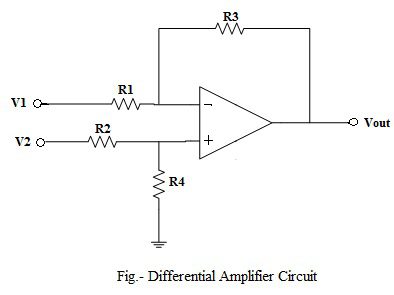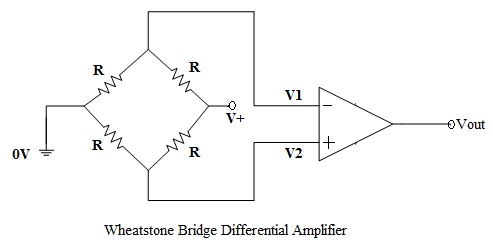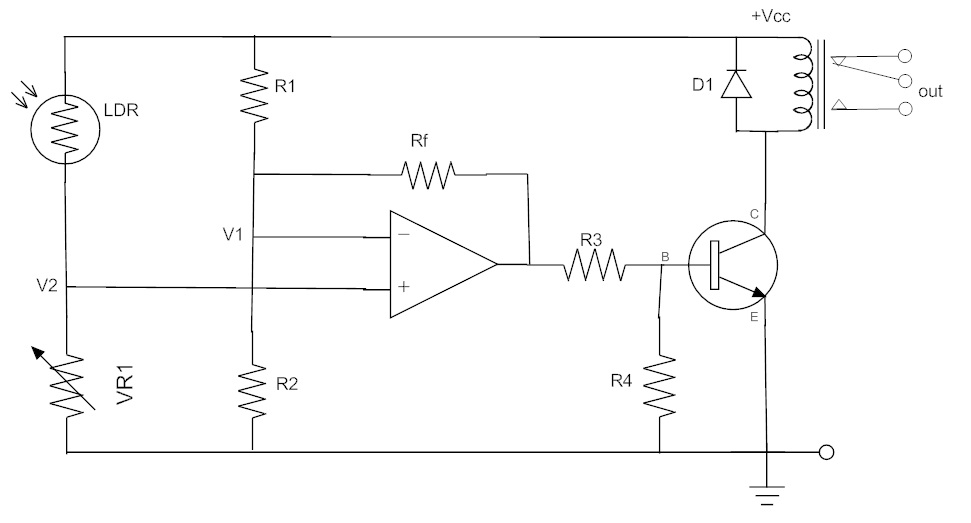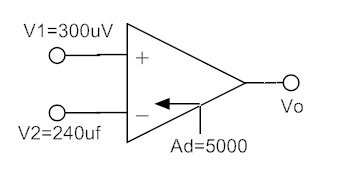In this tutorial, we will learn about one of the important circuit in analog circuit design: a Differential Amplifier. It is essentially an electronic amplifier, which has two inputs and amplifies the difference between those two input voltages.
Operational Amplifier is internally a Differential Amplifier with features like High Input Impedance, Low Output Impedance etc. For more information on Op-Amp, read “Operational Amplifier Basics“.
Introduction
The differential pair or differential amplifier configuration is a most widely used building block in analogue integrated-circuit design. It is the input stage of every operational amplifier, virtually.
A difference amplifier or differential amplifier amplifies the difference between the two input signals. An operational amplifier is a difference amplifier; it has an inverting input and a non-inverting input. But the open loop voltage gain of an operational amplifier is too high (ideally infinite), to be used without a feedback connection.
So, a practical difference amplifier uses a negative feedback connection to control the voltage gain of the amplifier.
Differential Amplifier
The difference amplifier shown in the above circuit is a combination of both inverting and non-inverting amplifiers. If the non-inverting terminal is connected to ground, the circuit operates as an inverting amplifier and the input signal V1 is amplified by – (R3 / R1).
Similarly, if the inverting input terminal is connected to ground, the circuit behaves as a non-inverting amplifier. With the inverting input terminal grounded, R3 and R1 function as the feedback components of a non-inverting amplifier.
Input V2 is potentially divided across resistors R2 and R4 to give VR4, and then VR4 is amplified by (R3 + R1) / R1.
With V2 = 0,
VO1 = -(R3 / R1) * V1
With V1 = 0,
VR4 = {R4/(R2+R4)}*V2
and
VO2 = {(R1+R3)/R1}*VR4
Therefore,
VO2 = {(R1 + R3) / R1} * {R4 / (R2 + R4) } * V2
If the input resistances are chosen such that, R2 = R1 and R4 = R3, then
VO2 = {R3 / R1} * V2
Now, according to superposition principle if both the input signals V1 and V2 are present, then the output voltage is
VO = VO1 + VO2
= {-(R3 / R1) * V1} + {R3 / R1} * V2
Which results in,
VO = (R3 / R1) * {V2 – V1}
When the resistors R3 and R1 are of the same value, the output is the direct difference of the input voltages applied. By selecting R3 greater than R1, the output can be made an amplified version of the difference of the input voltages.
Input Resistance
One problem with selecting the difference amplifier resistors as R2 = R1 and R3 = R4 is that the input resistances for both inverting amplifier and non-inverting amplifier are unequal.
The input resistance for voltage V1 is R1 as in the case of an inverting amplifier. For the non-inverting input, i.e. for input voltage V2, the input resistance is (R2 + R4).
This difference in the input resistances causes one of the input signals to be more amplified than the other.
The output equation of the difference amplifier VO, can be obtained by making the ratio R4 / R2 the same as R3 / R1, instead of making R2 = R1 and R4 = R3.
The input resistance difference will not cause a problem if the signal source resistances are much smaller than the input resistances. Also, it is usually desirable to have R2 = R1 and R4 = R3, in order to minimize the input offset voltages.
Differential Gain
The differential gain of a difference amplifier is defined as the gain obtained at the output signal with respect to the difference in the input signals applied.
The output voltage of a difference amplifier is given as,
VO = AD (V1 – V2)
where, AD = – (R3 / R1) is the differential gain of the amplifier.
Common Mode Input
A difference amplifier amplifies the difference between the two input voltages. Ideally, a common mode input Vcm would make the inputs (V1 + Vcm) and (V2 + Vcm), which will result in Vcm being cancelled out when the difference of the two input voltages is amplified.
Since the output of a practical difference amplifier depends upon the ratio of the input resistances, if these resistor ratios are not exactly equal, then one input voltage is amplified by a greater amount than the other input.
Consequently, the common mode voltage Vcm will not be completely cancelled. Because it is practically impossible to match resistor ratios perfectly, there is likely to be some common mode output voltage.
With the common mode input voltage present, the output voltage of the differential amplifier is given as,
VO = AdVd + Ac Vc
Where Vd = the difference voltage V1-V2
Vc = the common mode voltage (V1+V2)/2
Common Mode Rejection Ratio (CMRR)
The ability of a differential amplifier to reject common mode input signals is expressed in terms of common mode rejection ratio (CMRR). The common mode rejection ratio of a differential amplifier is mathematically given as the ratio of differential voltage gain of the differential amplifier to its common mode gain.
CMRR = | Ad / Ac|
Ideally, the common mode voltage gain of a differential amplifier is zero. Hence the CMRR is ideally infinite.
Characteristics of a Differential Amplifier
- High Differential Voltage Gain
- Low Common Mode Gain
- High Input Impedance
- Low Output Impedance
- High CMRR
- Large Bandwidth
- Low offset voltages and currents
Differential Amplifier as Comparator
A differential amplifier circuit is a very useful op-amp circuit, since it can be configured to either “add” or “subtract” the input voltages, by suitably adding more resistors in parallel with the input resistors.
A Wheatstone bridge differential amplifier circuit design is as shown in the figure above. This circuit behaves like a differential voltage comparator.
By connecting one input to a fixed voltage and the other to a thermistor (or a light-dependent resistor), the differential amplifier circuit detects high or low levels of temperature (or intensity of light) as the output voltage becomes a linear function of the changes in the active leg of the resistive bridge network.
A Wheatstone bridge differential amplifier can also be used to find the unknown resistance in the resistive bridge network, by comparing the input voltages across the resistors.
Light Activated Switch using Differential Amplifier
The circuit shown in the figure above acts as a light-dependent switch, which turns the output relay either “on” or “off” as the intensity of the light falling upon the light-dependent resistor (LDR) exceeds or falls below a pre-set value at the non-inverting input terminal V2.
The voltage V2 is determined by the variable resistor VR1. The resistors R1 and R2 act as a potential divider network. A fixed reference voltage is applied to the inverting input, through R1 and R2.
The same circuit can be modified to detect variations in temperature, simply by replacing the LDR by a Thermistor. By interchanging the positions of LDR and VR1, the circuit can be made to detect dark or light (or heat or cold with the use of a thermistor).
Differential Amplifier Example
Determine the output voltage of a differential amplifier for the input voltages of 300µV and 240µV. The differential gain of the amplifier is 5000 and the value of CMRR is (i) 100 and (ii) 105
The differential amplifier for the given data is represented as shown in the figure.
i) CMRR = Ad / Ac
100 =5000 / Ac
Ac = 50
Vd = V1 – V2 = 300µV – 240µV = 60µV
Vc = (V1 + V2)/2 = 540µV / 2 = 270 µV
VO = Ad Vd + Ac Vc
= [5000 x 60 + 50 x 270] µV
VO = 313500 µV = 313.500 mV
ii) CMRR = 105
Ac = Ad / CMRR = 5000 / 105 = 0.05
VO = AdVd + Ac Vc = [5000×60 + 0.05×270] µV
VO = 300013.5 µV
Note: Ideally, Ac iszero. So the output is only AdVd, which results in VO = 5000 x 60 µV = 300mV.
Differential Amplifier Summary
- A differential amplifier also known as difference amplifier is a useful op-amp configuration that amplifies the difference between the input voltages applied.
- A differential amplifier is a combination of both inverting and non-inverting amplifiers. It uses a negative feedback connection to control the differential voltage gain.
- The differential voltage gain of the amplifier is dependent on the ratio of the input resistances. Therefore, by choosing the input resistances carefully, it is possible to accurately control the gain of the difference amplifier.
- The common mode gain of a differential amplifier is ideally zero. But due to mismatch in the resistor values, there will be a very small common mode output voltage and a finite common mode gain.
- By suitably modifying the resistor connections at the input terminals, a difference amplifier can be made to add, subtract and compare the input voltage levels applied.
Previous Post – Summing Amplifier
Next Post – Instrumentation Amplifier
The post Differential Amplifier appeared first on Electronics Hub.




0 Comments